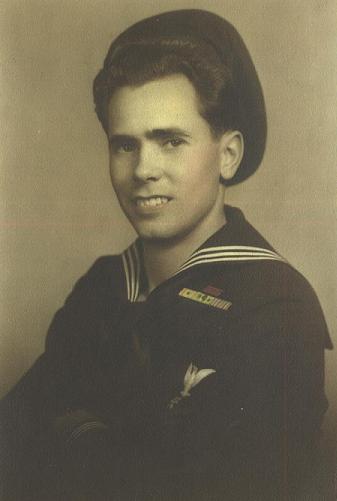Clyde J. Combs US Navy USS Arizona |
On the morning of December 7, 1941, I was in the Chief's Quarters way up forward folding my laundry. One of the Chiefs yelled, "Hey, the California is on fire." I looked up to see a Jap plane shooting out at Ford Island. I recognized the "Rising Sun" on his wing. I didn't have to think. I knew we were being attached, so I did a hundred yard dash aft to my battle station, which was in Turret 3. I passed the O.D. (officer of the deck) who at that time sounded G.Q. which meant, "Report to your battle stations." (Those few seconds head start were one of the reasons I survived). I made it almost to Deck 7 when a bomb exploded nearby. We who were there couldn't breathe, but finally made it into the lower powder handling room of Turret 3. We didn't know of the damage at the time except we could feel we were listing to port and suspected we were sinking. It was impossible to perform our battle station duties in Turret 3 because the powder was wet and the hoist had no electrical power. All we could do was go up in the gun room as the rising water dictated. We stayed there until around 9:30 a.m. and finally went out on deck and were SHOCKED BEYOND BELIEF AT WHAT HAD HAPPENED TO OUR HOME. The deck was riddled with bullet holes, and body parts were scattered everywhere. The body of one of my friends was hanging from the mast. We couldn't do anything to help anyone so four or five of us removed some of our clothing and shoes and jumped overboard into the burning water in order to swim to Ford Island, which was approximately 100 yards away. BAD IDEA! It was impossible to swim so we made our way back to the quay and to the ladder leading back to the ship's deck. Luckily, that part of the ship had not sustained much damage. Minutes later a sailor walked out of a burning compartment and said, "Help me Combs." I didn't know who he was since he was burned beyond recognition. In the meantime our Division Officer had gotten the Captain's gig going and was picking up casualties, so we got the burned sailor down into the boat. He died on the way to the beach. I later learned that his name was Wilfred John Criswell, one of my best friends from Indiana. Once on Ford Island we found a bunker where sailors and families were collecting. Finally, the sailors were moved to a location at the base where we reported, in, giving our names, ships and other information. From there we were sent to a sunken, open air theater where we stayed until we were reassigned to a new duty station. I chose to be transferred to the USS Selfridge (DD357). This duty lasted until the war was over and was mostly in the Pacific Theater, which was full of more war. It was very sad losing 1, 077 of my shipmates and difficult to understand why I survived and they didn't. Yet, I can say that the Navy prepared me well, especially in the areas of plane recognition and discipline duty. These things, along with the fact that my battle station was one of only 2 safe places on the ship, and my advance sprint to that location, were probably what saved me that day. Information provided by Clyde J. Combs |
